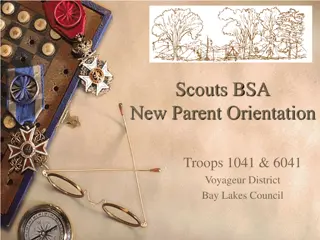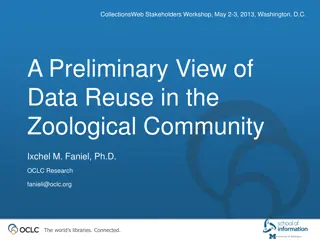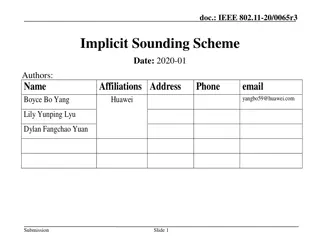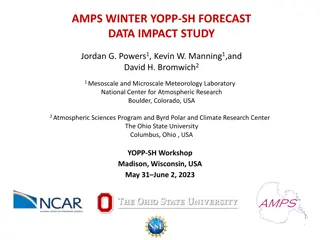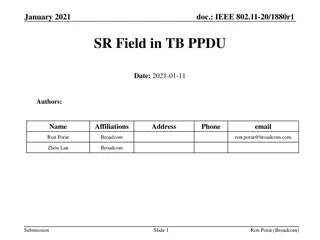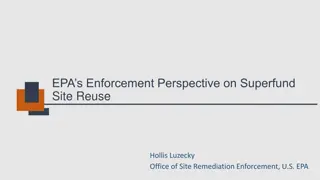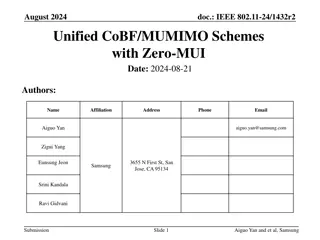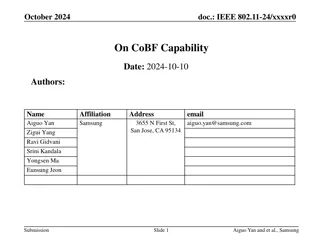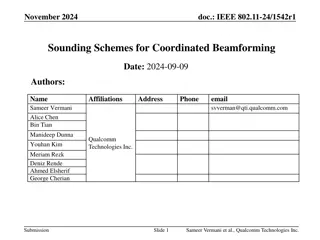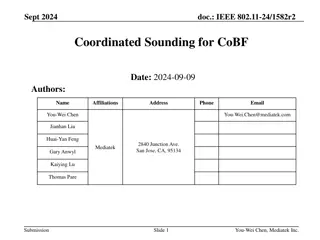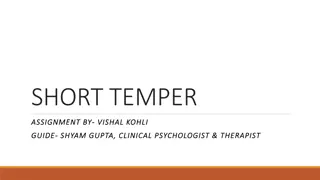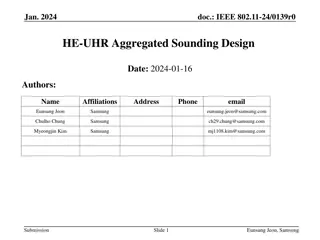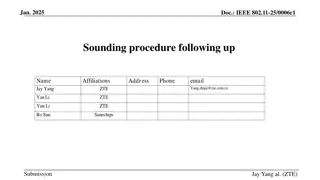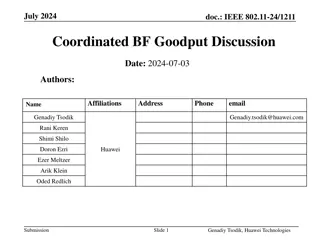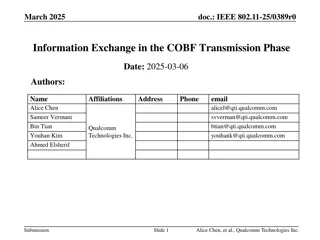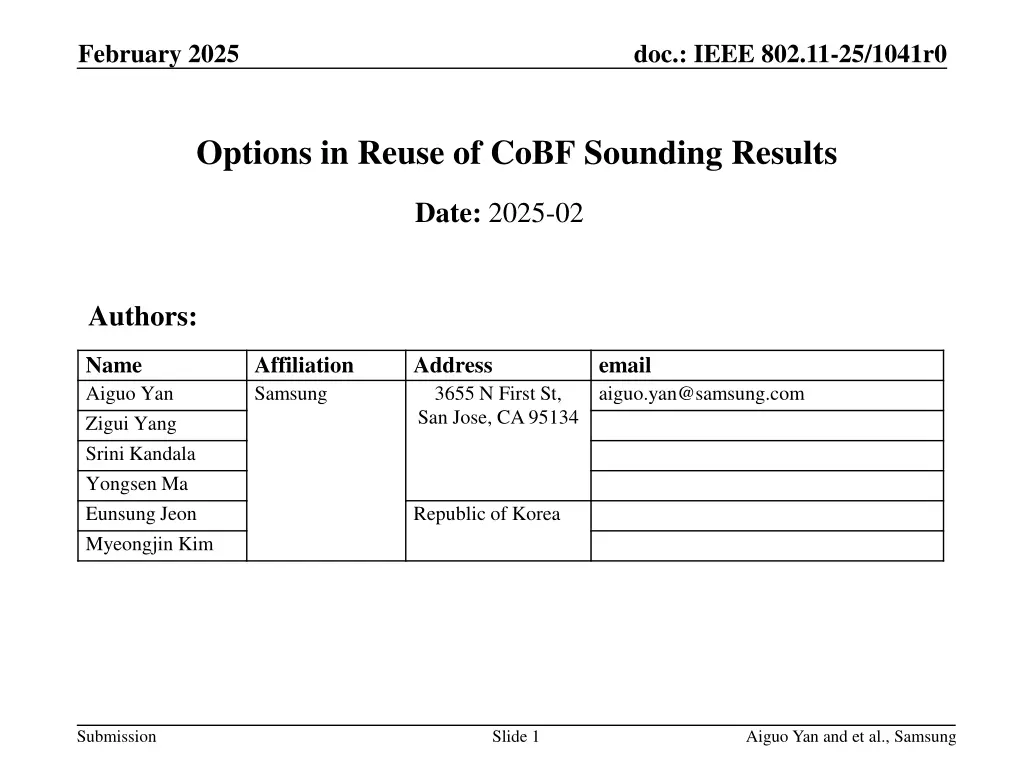
Options for Reuse of CoBF Sounding Results
Discover innovative schemes for reusing CoBF sounding results in IEEE 802.11-25/1041r0 document presented by Samsung. Explore the benefits of CoBF, channel estimation, and various types of SVDs for optimal performance in SU/MU-MIMO scenarios.
Download Presentation

Please find below an Image/Link to download the presentation.
The content on the website is provided AS IS for your information and personal use only. It may not be sold, licensed, or shared on other websites without obtaining consent from the author. If you encounter any issues during the download, it is possible that the publisher has removed the file from their server.
You are allowed to download the files provided on this website for personal or commercial use, subject to the condition that they are used lawfully. All files are the property of their respective owners.
The content on the website is provided AS IS for your information and personal use only. It may not be sold, licensed, or shared on other websites without obtaining consent from the author.
E N D
Presentation Transcript
February 2025 doc.: IEEE 802.11-25/1041r0 Options in Reuse of CoBF Sounding Results Date: 2025-02 Authors: Name Aiguo Yan Zigui Yang Srini Kandala Yongsen Ma Eunsung Jeon Myeongjin Kim Affiliation Samsung Address 3655 N First St, San Jose, CA 95134 email aiguo.yan@samsung.com Republic of Korea Submission Slide 1 Aiguo Yan and et al., Samsung
February 2025 doc.: IEEE 802.11-25/1041r0 Background and Outline 1. 2. CoBF is a major innovation for 11bn Both sequential and joint sounding schemes are defined [15] It is beneficial to increase chance of using CoBF [2] It is very desirable of re-using CoBF sounding results for SU/MU-MIMO [16] We proposed a scheme which meets needs of #3 and #4 above. [1-4] In addition, we can enable optimal channel smoothing filtering of channel estimation in participating STAs of CoBF [10] 3. 4. 5. 6. Submission Slide 2 Aiguo Yan and et al., Samsung
February 2025 doc.: IEEE 802.11-25/1041r0 3 Types of SVDs , : Channels of STA1 from AP1/2 H H 11 12 ( ) ;svd ) Joint SVD: svd , H H 11 12 ( ( ) Individual SVD: svd H H 11 12 Note: Q*H12 has smaller dimension (1) 11 0 0 S H U = (1) 11 (0) 11 (1) 11 (0) 11 , , H U V V 11 (0) 11 S ( ) H ( ) ( ) = (1) 11 ) Separated SVD: svd ;svd ; is one choice H QH Q U 11 12 = In dividual SVD = Separated SVD (with Q I Submission Slide 3 Aiguo Yan and et al., Samsung
February 2025 doc.: IEEE 802.11-25/1041r0 A Likely Configuration (with Seq Sounding) NDPA NDP BFRP NDPA BFRP NDP AP1 2 APs, each having 4 antennas 4 STAs, each having 2 antennas NDP NDPA NDP BFRP NDPA BFRP AP2 STA1/2 Associated with AP1 CSI CSI STA1 STA3/4 Associated with AP2 CSI CSI AP1 STA2 : Channels of STA1 from AP1/2 Seq Sounding (similar to SU-Sounding) and Individual SVD ; Both are unitary V V , H H 11 12 STA3 = = H H . H U S V H U S V AP2 inBSS 11 11 11 11 and 12 12 12 12 11 12 ( ), k V STA4 Feedback: ( ); k S ( ), k V ( ) ;Good for SU k /MU-MIMO S 11 11 12 12 But the feedback is not good for CoBF (partial nulling) [1-4] Both V11 and V12 are 4x2 Submission Slide 4 Aiguo Yan and et al., Samsung
February 2025 doc.: IEEE 802.11-25/1041r0 A Likely Configuration (with Joint Sounding) 2 APs, each having 4 antennas 4 STAs, each having 2 antennas NDPA NDP BFRP NDP AP1 NDP NDPA NDP BFRP AP2 STA1 STA1/2 Associated with AP1 CSI AP1 STA2 STA3/4 Associated with AP2 CSI : Channels of STA1 from AP1/2 Joint Sounding and Joint SVD: , H H 11 12 STA3 = , H H H AP2 1 11 12 1 1 11 U SV = = = H H H H H , , H 1 1 1 U SV U S V V 1 1 12 U SV 1 1 1 11 12 STA4 Neither nor is unitary.Feedback: ( ), ( ) V V S k V k 11 12 1 1 H1 is 2x8, V1 is 8x2; Both V11 and V12 are 4x2 is not friendly fo r re-using in SU/MU-MIMO V 11 Submission Slide 5 Aiguo Yan and et al., Samsung
February 2025 doc.: IEEE 802.11-25/1041r0 A Recommendation Separated SVD 2 APs will send total 4 SS down 1 SS per STA in this example. U11(1) is 2x1, V11(1) is 4x1 H12new is now 1x4, V12New is 4x1 , : Channels of STA1 from AP1/2 H H 11 12 (1) 11 0 0 S H U = = (1) 11 (0) 11 (1) 11 (0) 11 H , , H 11 11 11 U S V U V V 11 (0) 11 S Optimal SVD [10] ( ) ( ) H H = = (1) 11 new New New New H U H U S V 12 12 12 12 12 (1) 11 New (1) 11 New V V V V 1 1 = (1) 11 Joint Sounding: feedback ( ), k V k ( ) ,and or S V 1 1 2 2 12 12 (1) 11 (1) 11 New New Seq Sounding: feedback ( ), k V ( ) or k ( ), k V ( ) , k ( ), k V ( ) k S S S 11 11 12 12 Existing sounding and feedback mechanism are re-used 100% Feedbacks are good for both CoBF and (Optimal) MU/SU-MIMO, in both Joint and Seq soundings. [10],[12] Submission Slide 6 Aiguo Yan and et al., Samsung
February 2025 doc.: IEEE 802.11-25/1041r0 Options with Standards 1. It is much more advisable for APs to explicitly instruct STAs to do separated SVD or default SVD. 2. On the other hand, STAs could choose always to do separated SVD 1. 2. APs have certain knowledge of STAs Separated SVD results in smaller Nc than individual SVD UL: 1. Seq Sounding: AP can use {Nc} to determine if a STA is doing individual or separated SVD [note: individual = separated with full-nulling] 2. Joint Sounding: The property of feedbacked V matrices indicates separated SVD or not V V 1 2 = H H 11 ; ; for seperated SVD V V V I V V I 1 11 11 12 12 12 Submission Slide 7 Aiguo Yan and et al., Samsung
February 2025 doc.: IEEE 802.11-25/1041r0 Case of an Advanced Configuration 2 APs, with 8 TX Ants/AP 4 STAs, with 4 RX Ants/STA (Note: UEQM is defined for up to 4 SS) 1. Joint Sounding is not supported (due to 16 ants) this is a right call! 2. Current Seq sounding doesn t work for CoBF (due to more RX ants). 3. Flagship APs and Flagship STAs can t work together with CoBF. This sounds strange??? 4. We, of course, can always downgrade CoBF to with only 2 STAs. With the separated SVD, this advanced configuration can be supported! Submission Slide 8 Aiguo Yan and et al., Samsung
February 2025 doc.: IEEE 802.11-25/1041r0 Simpler Cases (# of TX ants/AP = # of total RX ants) 1. 2APs with 4TXAnts/AP + 4STAs with 1RXAnt/STA 2. 2APs with 4TXAnts/AP + 2STAs with 2RXAnts/STA 3. Full nulling can be achieved with either Joint or Seq sounding feedbacks. 4. Individual SVD with Seq sounding is friendly to re-use. [Note: individual = separated with these simple cases] 5. But Joint SVD is unfriendly to re-use But STA can choose to do separated/individual SVD. Benefit: both Seq and Joint sounding can support re-use, with the separated SVD. Submission Slide 9 Aiguo Yan and et al., Samsung
February 2025 doc.: IEEE 802.11-25/1041r0 Summary of case analysis Zero- MUI Adv Case (8TX AP, 4 4RX STAs) Seq Sounding (Individual SVD) Seq Sounding (Separated SVD) Most Likely Case (4TX AP, 4 2RX STAs) Joint Sounding (Joint SVD) Joint Sounding (Separated SVD) Seq Sounding (Individual SVD) Seq Sounding (Separated SVD) Simple Case #1 (4TX AP, 2 2RX STAs) Joint Sounding (Joint SVD) Joint Sounding (Separated SVD) Seq Sounding (Individual SVD) Seq Sounding (Separated SVD) Simple Case #2 (4TX AP, 4 1RX STAs) Joint Sounding (Joint SVD) Joint Sounding (Separated SVD) Seq Sounding (Individual SVD) Seq Sounding (Separated SVD) Supported Y New Nulling Partial N Partial Y Resue Note Y Y Y New Y New Partial Y Partial Y Partial N Partial Y N Y Y Y With Fulling nulling: individual SVD = separated SVD Y New Y New Full Full Full Full Y Y Y Y N Y Y Y Y New Y New Full Full Full Full Y Y Y Y N Y Y Y With the separated SVD, re-use can be supported in ALL configurations, with at least one of sounding modes. Submission Slide 10 Aiguo Yan and et al., Samsung
February 2025 doc.: IEEE 802.11-25/1041r0 All Valid CoBF Configs with Seq Sounding (full Nulling) Assuming that 1RX STAs are of low-cost, and hence don t support CoBF a) [1 1 1 1] b) [1 1 1] c) [1 1] d) [2 1 1] e) [2 1] f) [2,2]: only config which can enable reuse of CoBF CSI feedbacks (without separated SVD) 3 STAs with 2, 1, and 1 ant respectively 2 STAs with 2, and 1 ant respectively 2 STAs with 2, and 2 ants respectively Submission Slide 11 Aiguo Yan and et al., Samsung
February 2025 doc.: IEEE 802.11-25/1041r0 BF Based on Optimal SVD [1, 10, 13,18-20] Use STA1 as an example , : Channels of STA1 from AP1/2 H H 11 12 (1) 11 0 0 S H U = (1) 11 (0) 11 (1) 11 (0) 11 , , H U V V Optimal SVD 11 (0) 11 S (channel smoothing filtering) ( ) ( ) H H (1) 11 (1) 11 (1) 11 ; ; all OK V V V = = (1) 11 new New New New H U H U S V 12 12 12 12 12 (1) 11 New (1) 11 New V V V V 1 1 = (1) 11 Joint Sounding: feedback ( ), k V k ( ) ,and or S V 1 1 2 2 12 12 = (1) 11 BF SU/MU-MIMO and CoBF: Better enable "channel smoothing filtering" in STAs ( ) k ( ) k V ( ), with STA as an example k H H 11 11 1 1. No PPDU data from AP2 to STA1 2. They are therefore less important Submission Slide 12 Aiguo Yan and et al., Samsung
February 2025 doc.: IEEE 802.11-25/1041r0 Summary of benefits with the separated SVD 1. Enable reuse of CoBF sounding results in SU/MU- MIMO. 2. Increase chance of using CoBF. 3. Re-use existing feedback scheme. 4. Ask no changes on existing pre-coder or receivers 5. Enable advanced APs/STAs to use CoBF efficiently [2]. 6. Better performance (about 2.0 dB) over joint SVD [3]. 7. Reduced computation load and simplified HW [1,3]. 8. Enable better channel smoothing filtering in STAs (SU, MU and CoBF) [1,10,13] Submission Slide 13 Aiguo Yan and et al., Samsung
February 2025 doc.: IEEE 802.11-25/1041r0 SP Ideas for discussions 1. APs have the option to explicitly instruct STAs to perform either separated SVD or default SVD. for Sequential sounding only, or for both? 2. STAs has the option to explicitly indicate sounding results are from either separated SVD or default SVD. for Sequential sounding only, or for both? 3. The sounding mechanism for CoBF has the option to do inBSS sounding first. Submission Slide 14 Aiguo Yan and et al., Samsung
February 2025 doc.: IEEE 802.11-25/1041r0 References 1. 2. 3. 4. 5. 6. 7. 8. 9. 10. 11. 12. 13. 14. 15. 16. 17. 18. 19. 20. 24/1432: Unified CoBF and MUMIMO Schemes with Zero MUI (Aiguo of Samsung) 24/1836: On CoBF Capabilities (Aiguo of Samsung) 24/1789: cobf-partial-nulling-feedback-types (Rani of Huawei) 23/1998: Zero-MUI Coordinated Beamforming (Shimi of Huawei) 24/1204: Coordinated Beamforming for 11bn (Insik of LGE) 24/1515: Coordinated Beamforming for 11bn - Follow Up (Insik of LGE) 24/0011: Coordinated Spatial Nulling (C-SN) Concept (MaxLinear) 24/0012: Coordinated Spatial Nulling (C-SN) Simulations (MaxLinear) 23/0776: Performance of C-BF and C-SR (Ron of BRCM) 24/1431: Enhancing BF Feedback Mechanism in 11bn (Aiguo of Samsung) 22/1820: BF Feedback with the Optimal SVD (Aiguo of Zeku) 22/1869: TXBF based on the Optimal SVD (Aiguo of Zeku) 22/1413: Thoughts-on-High-Reliability-Communications (Aiguo of Zeku) Book: Next Generation Wireless LANs 80211n and 80211ac 24/1542: Sounding Schemes for Coordinated Beamforming (Sameer of QCOM) 25/0103: Simplified-carrier-synchronization-for-cobf-transmissions (Julia of MTK) 25/0083: CFO correction and related simplifications for COBF (Sameer of QCOM) 23/1906: Channel-information-feedback-for-smooth-beamforming-followup (Eunsung of Samsung) 22/1842: Channel-information-feedback-for-smooth-beamforming (Eunsung of Samsung) 22/1392: Beamforming-improvement-for-uhr (Eunsung of Samsung) Submission Slide 15 Aiguo Yan and et al., Samsung
February 2025 doc.: IEEE 802.11-25/1041r0 Backup: CoBF Zero-MUI (Equivalence of Schemes) Each STA has 3 or more physical, but only 2 virtual, antennas. [1] Zero-MUI with this set of Virtual Antennas are guaranteed. (1) 1 S H 1 U = = (1) 1 (0) 1 (1) 1 (0) 1 , , , H H H U V V Q H11 1 11 12 STA1 (0) 1 S 1 2 H12 AP1 ( ) H (1) 11 (1) 12 has shape of V = (1) 1 for the joint SVD Q U (1) 1 V 1 H21 Q 8 V STA2 2 (1) 11 S H H22 U = (1) 11 (0) 11 (1) 11 (0) 11 , , H U V V 11 (0) 11 S H31 1 Q ( ) H H32 STA3 = (1) 11 3 for the separated SVD Q U 2 1 AP2 H41 Q 8 H42 = for the individial SVD But the Zero-MUI can't be guaranteed. STA4 Q I 4 1 Submission Slide 16 Aiguo Yan and et al., Samsung



